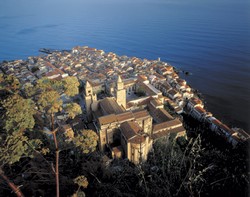Our tour will start by picking you up from your location, driving in the north of the island to visit the second summer reasort of Sicily and one of the most charming fishing towns on the island. It was founded by the Greeks in the 4th century BC and later on occupied by the Romans. But the apogee of the town dates from the Norman age, when the king Roger II decided to build in 1131 a very beautiful Cathedral and gave the town many privileges. The Cathedral of Jesus Christ the Saviour is the most important monument in the town: it was planned as the burial place of Roger II and his family.
It shows a very interesting combination of different styles: Arabic, Byzantine, Romanesque and Baroque. The façade is flanked by two massive bell-towers and preceded by a portico from the 15 th century. The interior walls are rather naked while the main apse is occupied by a wonderful mosaic in Byzantine style, representing the Almighty God surrounded by the Archangels, the Apostles, the Virgin Mary and the Saints of the Christian Church. This beautiful mosaics are considered among the purest Byzantine mosaics of Sicily. To the right of the choir , there is still the old bishop’s throne, and on the left the royal marble and mosaic throne.
The Arab-Norman “Lavatoio” is an old public wash-house, probably also known in the Roman era. The basins are supplied with water by a fresh-water spring running underground and coming from the mountain at the back of the town. The museum “Mandralisca, is housed in the palace once owned by the Baron Mandralisca, the first deputy of Cefalù in the newly created Italian Parliament of 1861. He was also an art lover who spent much of his time searching for rare objects.
The most interesting exhibits include coin collections, a “krater”, with an illustration of a fishmonger cutting up tuna fish on one side and on the other a picture of two young lovers (4th century BC); but the finest work of all is the Portrait of an Unknown Man, a masterpiece of 15th century Italian painting by Antonello da Messina.
We then take a drive to visit the beautiful Christian Sanctuary of Tindari, Legacy of ancient pagan fertility cults, evidence of unsuspected racial migrations, witness to the dark, mysterious aspects of the femininity of the Madonna: there are many theories concerning the Black Madonnas, but all agree that they are striking and mysterious representations, the origins of which we do not fully understand.
Tindari is mostly known for being the home of one of the most famous 'Black Madonna ‘s of Europe, the Madonna di Tindari. Although pilgrims attend the shrine where it is housed throughout the year, the annual festival takes place on the seventh of September, when masses are held every hour from early morning to midnight, and the Madonna herself is taken out for a procession in the evening. At midnight the festivities end with a display of fireworks.
The cult of the Black Madonna throughout Europe has been the source of much speculation. Historians of religion have used the various figures, especially common in France, Spain and Italy, to argue the case for a pre-Christian fertility cult centered on a 'Black Mother'. Feminists have explored and employed the image in various ways to argue for a countercultural Christian image of aggressive, 'dark' femininity, and Jungian psychoanalysts have used the images to represent the dark side of the female 'anima', an element of the human psyche.
This particular Madonna is said to have originated in Byzantium, and legend tells that a group of fishermen found it after it fell off a ship bound from the Orient, and handed it over to the local monks. These monks built a sanctuary for it, and it was later moved to the more recent, larger sanctuary where it currently resides. The older building behind the new sanctuary can still be visited by tourists during the day.




.jpg)